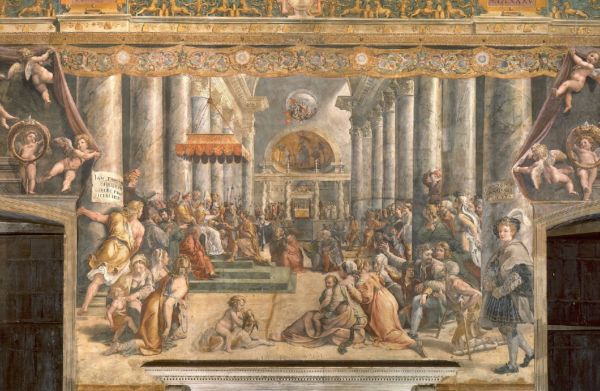
School of Raphael – Donation of Rome
A VISIT TO ST JOHN LATERAN
St. John Lateran retains, internally at least, its original Constantinian arrangement: a large rectangular hall with an impressive nave, flanked by double aisles and terminating in an apse. The Emperor seems to have conceived an edifice to rival the Roman basilicae, or monumental public meeting-halls of the imperial city. As we have mentioned several times, the imperial basilica provided the model for the great majority of Roman churches, from the earliest to most recent.
Even Borromini’s Baroque decor does not detract from the impression of an early Christian church. As usual, Borromini’s genius is not immediately evident. But any visitor will be rewarded by a close examination of the details and architectural solutions this resourceful artist managed to execute. The massive statues of Apostles which line the main nave (by various late Baroque artists, some followers of Gianlorenzo Bernini) fill their marble-columned niches, fairly bursting with psychological and aesthetic power. The figures of Matthew and Bartholomew, carrying his flayed skin, are especially impressive.
Above these powerful figures, Pamphili doves (family insignia of Innocent X) are prominently displayed in the pediments, topped by reliefs by Alessandro Algardi (1595–1654) of Old and New Testament scenes, and by painted medallions with prophets. A gold-leaf coffered ceiling bears the coats-of-arms of its patron Renaissance Popes, Pius IV (1559–65) and Pius V (1566–72). The ‘cosmatesque’-style pavement in polychrome marble, restored by Pope Martin V (1417–31), appears, somehow, much more recent.
St. John Lateran contains artistic treasures from every historic period, a tribute to the important role the basilica has played in the history of Rome and of the Roman Catholic Church. The cathedral also boasts an especially important Jubilee memento. On the second pilaster, between the main nave and the far right aisle, is a fragment of a fresco, attributed to Giotto, of Pope Boniface VIII (1294–1303) proclaiming the first Holy year in 1300 from the ‘loggia of the blessings’ in the medieval Lateran Palace.
During excavations carried out in 1934–5 beneath the central nave, significant pagan and early Christian remains were unearthed – floor mosaics, household implements, and even stretches of paved Roman streets. In a niche in the portico, an imposing fourth-century statue of the Emperor Constantine (from Constantine Baths on the Quirinal) is a reminder of the basilica’s origins, while the central bronze doors (second century) come form the Curia, or Senate, in the Roman Forum.
The apse mosaic was commissioned by Pope Nicholas IV (1288–92) in 1292, using designs and fragments of the original Constantinian decorations. The mosaic includes, besides the bust of Christ the Saviour surrounded by angels (perhaps a remnant of the fourth-century work), figures of the Virgin and saints, a magnificent jewelled cross, and pleasant scenes of animals and children frolicking in the River Jordan.
In this charming work of art, there are also smaller figures of St. Anthony and St. Francis of Assisi (Pope Nicholas was a Franciscan), as well as tiny portraits of the medieval Franciscan friar artists Jacopo Torriti and Jacopo da Camerino, crouched between the Apostles in the lower level. The donor, Pope Nicholas, kneels at the feet of the Virgin, who gently places her hand on his head. Below the apse mosaic, the walls and Papal throne are decorated with beautiful panels and discs of porphyry.
Excerpt from Hager, June. Pilgrimage: A Chronicle of Christianity Through the Churches of Rome. (Weidenfeld & Nicolson: London), 1999.
We will be going to visit the Basilica of St. John Lateran in our upcoming Journey Toward the Face of Christ pilgrimage this coming May/June 2022.








Leave A Comment
You must be logged in to post a comment.